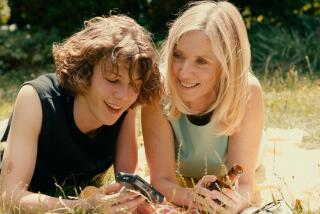Cinematographer Hélène Louvart shoots ‘Never Rarely’ as an intimate anti-road movie
Like the best ghostwriters, a cinematographer is a critical yet invisible shadow collaborator, deeply embedded in the drama but also set apart. To Hélène Louvart, the French-born director of photography on writer-director Eliza Hittman’s third feature, “Never Rarely Sometimes Always,” this allows her to tell the director’s story through her lens in the most honest way possible.
“We didn’t want to do a documentary,” she says of the film, an unflinching look at teenage pregnancy told through the eyes of two young women. “In a way, then, there is no stress or tension coming from the camera itself. Because I was with the lead, Autumn (newcomer Sidney Flanigan), at every step, I was a sort of ghost. Eliza prefers to be slightly invisible and never overt, even when we are obviously in the room and shooting our actors in such close proximity. She is right there with the character; their face is their heart.”
The film, which premiered at Sundance in 2020, was widely praised for its subtle yet powerful performances and quietly intense filmmaking. The Brooklyn-based Hittman, in fact, calls her story of a 17-year-old who must travel across state lines to get an abortion the “anti-’Juno.’”
“Eliza has to bring me into this mood along with the actors,” says Louvart, who first worked with Hittman on “Beach Rats,” her breakout second feature that became a festival favorite. “When she is behind me, I know exactly what to do; I feel where she wants the camera to go. It’s like choreography: You move without thinking too much, because you’ve mapped it out and planned, and everyone is on the same page at each moment.”
Louvart has more than 100 feature film credits and has worked with directors all over the world. She is known for her work on Wim Wenders’ seminal 3-D dance documentary “Pina” and for lensing French New Wave pioneer Agnès Varda’s cinematic memoir “The Beaches of Agnès,” winner of the César Award for best documentary in 2009.
That unconventional documentary experience made her an ideal fit for Hittman’s intimate anti-road movie told mostly in gorgeously grounded close-ups that Louvart shot in Pennsylvania and New York City. Because production began in winter and they were limited to available lighting in several of those locations, including on the subway and in the Port Authority bus terminal, the team chose to shoot in Super 16-millimeter film.
“It was always the plan to shoot in Super 16,” says Louvart. “For starters, it allows for a simple setup — a camera, lens and small matte box — that draws few onlookers. On the subway, we couldn’t add any other lights to what was already there, and Super 16 gives you something for the highlight and for the darker locations that aren’t very well lit. It also brings something organic to the images.”
She and Hittman chose Kodak 500 film stock for the same reason. “It’s good when you are shooting a range of scenes indoors and out, especially in the darker winter months. We wanted a film stock that could handle that.”
Whenever possible, Louvart says they diffused the existing light, occasionally bringing in small lights to mix with what was already there and sometimes switching off lights that were too strong. “When we could do it,” she says, “we aimed for a very flat light. We didn’t want to have lighting that was too harsh, and we didn’t want to do a lot of hand-held; it would be too much for the viewer. The subject is already not an easy one, so we didn’t want to create too much of a bleak and sad feeling.”
Flanigan, with a classical, enigmatic face lifted from a Da Vinci portrait, delivers a stoic yet transfixing performance as Autumn. Talia Ryder, a dancer and Broadway child actor also making her feature debut, plays Autumn’s cousin, Skylar, the spirited, instigating Louise to Autumn’s shyer Thelma. “Autumn may not show her emotions like Skylar does, but she is very courageous, and we wanted the picture to elevate her,” Louvart says. “Sidney had to trust us, because the camera was close to her so often. Without that trust, it’s not the same.”
Reached in Spain where she was scouting locations for her next project, Louvart recently wrapped “The Lost Daughter,” actress Maggie Gyllenhaal’s upcoming directorial debut, in Greece. “Whenever you shoot in another part of the world, the way to speak about cinema and use the tools is exactly the same,” Louvart says. “It’s a communal language, whether you are shooting in São Paulo, New York, Croatia or Spain. For me, it’s very important to shoot in another country, because you learn other ways to think, as well as new ways to experience different kinds of light.”
It is also a crucial reminder, she says, that there is not only one sort of light or one sort of story. “It opens your mind as a visual storyteller. And that can only increase the way you think about the world.”
More to Read
From the Oscars to the Emmys.
Get the Envelope newsletter for exclusive awards season coverage, behind-the-scenes stories from the Envelope podcast and columnist Glenn Whipp’s must-read analysis.
You may occasionally receive promotional content from the Los Angeles Times.









